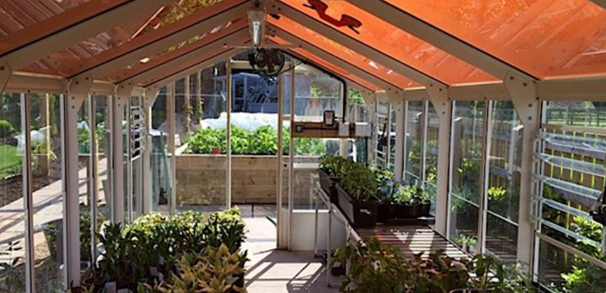PV project owners could ramp up their financial gains by harvesting crops and generating solar power from the same land, with gross financial gains of 2.5% for basil and 35% for spinach grown in greenhouses with tinted semi-transparent PV modules.
Researchers from the University of Cambridge described the potential gains in “Tinted semi-transparent solar panels allow concurrent production of crops and electricity on the same cropland,” which was recently published in Advanced Energy Materials.
Deploying bifacial modules above crops to harvest biomass and electricity from the same land has been done before. The cells and modules are usually further apart, allowing more sunlight to penetrate and reach the crops. However, shadows from opaque modules on crops cannot be avoided, and biomass growth falls in such applications.
New research suggests that using tinted semi-transparent modules could lead to better results. Polysolar, a Taiwan-based manufacturer of 20% transparent solar glass, has supplied the research modules. The thin‐film amorphous silicon modules have a transparent zinc oxide back conductive layer and clear front glass coated with fluorine tin oxide. The photovoltaic area of the modules is laminated in between two sheets of glass. According to the research paper the modules prompt 8% conversion efficiency and thus have an output of 66 W m?2.
The thinking behind using tinted modules is that plants and solar PV require light, but of a different wavelength and quantity. Using bespoke orange-tinted panels, the wavelength shining onto the crops inside the greenhouse is the one that is most productive for plants.
The photosynthetic pigment of plants, chlorophyll, has absorbance peaks in the blue (400-500 nm) and red (600-700 nm) and the green (500-600 nm) spectra. To protect the photosynthesis apparatus from excessive irradiation, plants have carotenoids and anthocyanins to absorb light in the blue (400-500 nm) and green light spectrums. Light absorbed in the blue and green spectrum therefore does not contribute to photosynthesis very much. By deploying a tinted solar panel that absorbs the blue and green spectra, the light hitting the plants has a much higher red spectrum, which is ideal for photosynthesis.
Though the use of tinted semi-transparent PV panels on greenhouses had been discussed before, no experimental trials had been done. In this test, the team grew 12 basil plants in a greenhouse in Italy during the spring/summer season. Six plants in the greenhouse featured tinted PV panels, while another six plants served as a reference in a conventional greenhouse. In a second test, the team also grew spinach plants during two fall/winter seasons.
The plants inside the greenhouses with tinted solar panels received 57% less solar radiation than the plants in the conventional greenhouses. Just as the researchers expected, the plants’ growth decreased at a rate that was not linear to the lack of light. The biomass growth fell by 30% for basil and by 28% for spinach. In these trials, the researchers also found that under the conditions created, the plants grew fewer roots and stems, but increased their leaf area to absorb the optimized light, which was ideal for leafy greens. For basil, the marketable biomass (leaves) declined by just 15% (26% for spinach).
The researchers looked at the financial impact of the exercise by considering the marketable yield of the crops and the global wholesale price, in order to calculate the income on the basil and spinach. Then the team looked at total electricity generation and matched that with the feed-in tariff of Italy, where the test was done.
In the experiment, the basil produced $19.4/ m?2 in the PV greenhouse, compared to $22.8/ m?2 in the conventional greenhouse. The loss was offset by 27.8 kWh/m?2 PV production, which generated an income of $4.02/ m?2. The total gross value for the two greenhouses was $22.8/m?2 for the conventional greenhouse, while it was $23.4/m?2 for the tinted-module-roofed-greenhouse, up 2.5%.
“For high value crops like basil, the value of the electricity generated just compensates for the loss in biomass production caused by the tinted solar panels. But when the value of the crop was lower, like spinach, there was a significant financial advantage to this novel agrivoltaic technique,” said Paolo Bombelli, a researcher at the University of Cambridge’s Department of Biochemistry.
The results were even better with the spinach. The plants produced $3.11/m?2 of marketable biomass under the tinted PV modules, compared to $4.18/m?2 under clear glass. Electricity generation was 17.6 kWh/m?2, resulting in the opportunity to recoup $2.55/m?2 under the Italian FIT scheme. A spinach farmer would thus generate $5.66/m?2 with a PV greenhouse, compared to $4.18/m?2 under clear glass conditions – an increase of 35%.
“Our calculations are a fairly conservative estimate of the overall financial value of this system. In reality if a farmer were buying electricity from the national grid to run their premises then the benefit would be much greater,” said Professor Christopher Howe of the University of Cambridge’s biochemistry department.
The plants metabolically adapted to the new light conditions, and the leaves showed much higher protein levels than the reference plants. More trials could be done to determine whether it’s possible to tinker with the optical properties of the panels so the plants store the desired nutrients in their leaves.
“From a farmer’s perspective, it’s beneficial if your leafy greens grow larger leaves – this is the edible part of the plant that can be sold. And as global demand for protein continues to grow, techniques that can increase the amount of protein from plant crops will also be very beneficial,” said Bombelli.






